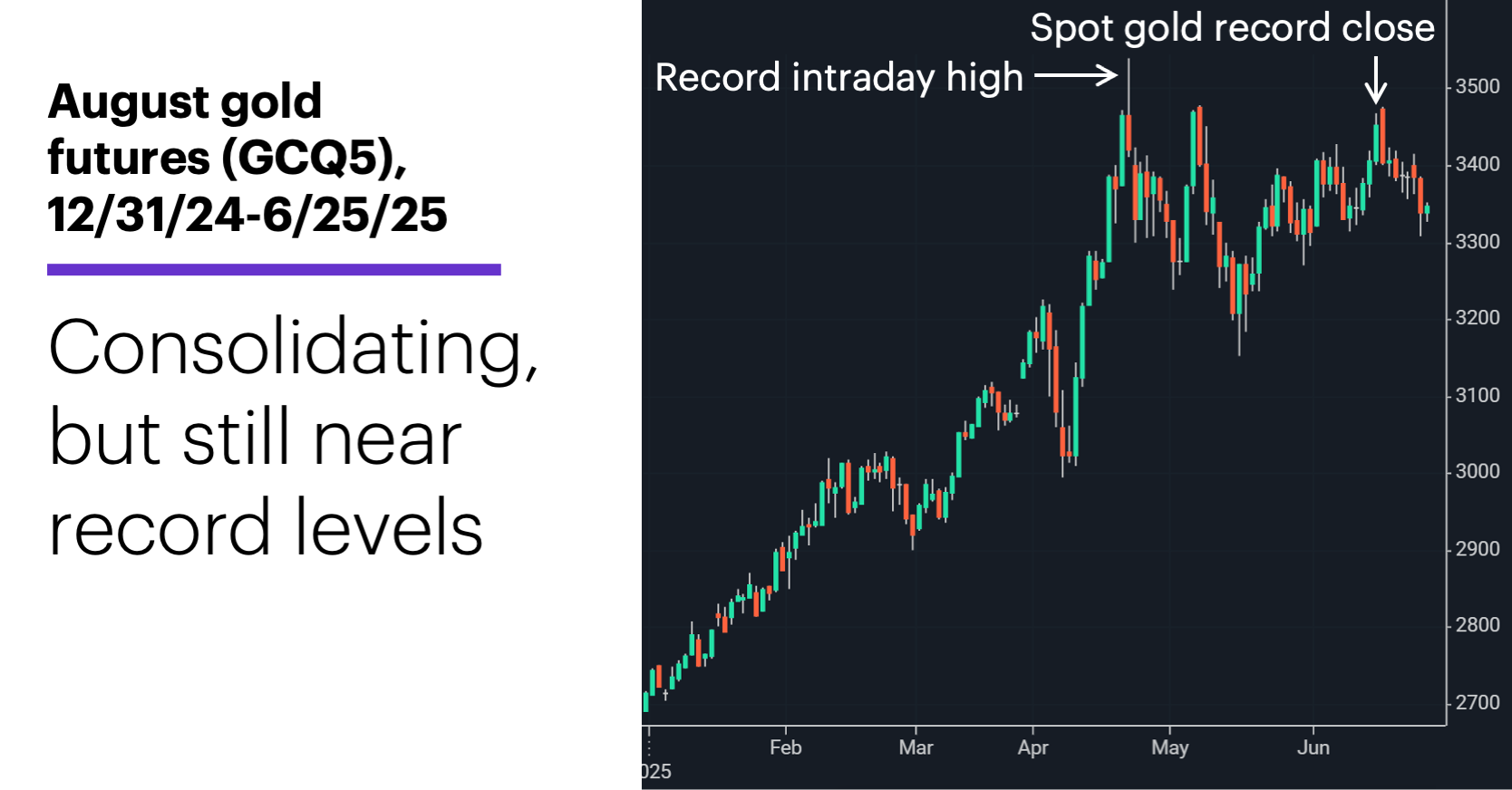Gold: Follow the money?
- Gold up roughly nearly 28% so far this year
- Market has mostly consolidated since late April
- Key indicator: strong negative correlation to dollar
Materials is the S&P 500’s fifth-weakest sector so far this year, but its metals and mining subgroup has one of the index’s strongest industry returns—nearly 24%.
For an explanation, look no further than the rallies in precious metals, including gold, which was up more than 27% for the year as of Wednesday:

Source: Power E*TRADE. (For illustrative purposes. Not a recommendation.)
While gold’s strength in recent months has been attributed largely to its role as a safe haven in the face of tariff and geopolitical uncertainty (its most recent record close occurred on June 13 after Israel’s airstrikes on Iran), Morgan Stanley & Co. analysts recently highlighted a few other factors—including gold’s (recently) unusual relationship to the dollar.
In early June, gold and the US dollar index (DXY) had an inverse correlation of -96% over the past five months, meaning the two markets had moved in nearly perfect opposition. Since 1990, the average five-month correlation was a much milder -39%, and only seven other periods since then have had negative correlations stronger than -95%.1
Their analysis showed such strong inverse relationships between gold and the dollar have usually been associated with above-average gold returns. While gold's average five-month return since 1990 is 3%, it was 8% when during the periods with the negative correlation with the DXY was stronger than -95%.
But they also point out that gold was often supported by other factors in the periods, including ETF inflows, safe-haven demand, and central bank buying—catalysts that have also been evident in 2025.
So far this week, the DXY has challenged the three-year lows (around 97.60) it hit earlier this month. While the analysts cited a Q3/Q4 target price for gold of $3,500, they also noted their currency strategists think the DXY could fall to 91 by Q2 2026—which, if the current inverse gold-DXY continued, would imply a gold price of $3,800.
That said, they point out the periods of strong negative correlation don’t necessarily last—the longest was 44 days, and the current one had reached 30 days as of Wednesday. As a result, they think the trajectory of ETF inflows will be an important factor in determining whether gold can break out of its consolidation and climb to new highs.
Market Mover Update: August WTI crude oil futures (CLQ5) bounced more than 1% Wednesday following the market’s second-biggest two-day drop (-12.7%) of the past three years (see “Energy deck gets shuffled”).
After falling to a six-day intraday low and testing its recent breakout level, Delek (DK) reversed to close higher on Wednesday. Total open interest in the July $22.50 and $25 call options was more than 20,000 contracts (see “Deciphering unusual options activity”).
Today’s numbers include (all times ET): durable goods orders (8:30 a.m.), Q1 final GDP estimate (8:30 a.m.), weekly jobless claims (8:30 a.m.), advance international trade in goods (8:30 a.m.), Chicago Fed National Activity Index (8:30 a.m.), advance retail and wholesale inventories (8:30 a.m.), pending home sales (10 a.m.), EIA Natural Gas Report (10:30 a.m.).
Today’s earnings include (all times ET): Acuity (AYI), Concentrix (CNXC), Enerpac Tool Group (EPAC), McCormick & Company (MKC), Nike (NKE).
Click here to log on to your account or learn more about E*TRADE's trading platforms, or follow the Company on Twitter, @ETRADE, for useful trading and investing insights.
1 MorganStanley.com. Gold: Another Day, Another $. 6/4/25.